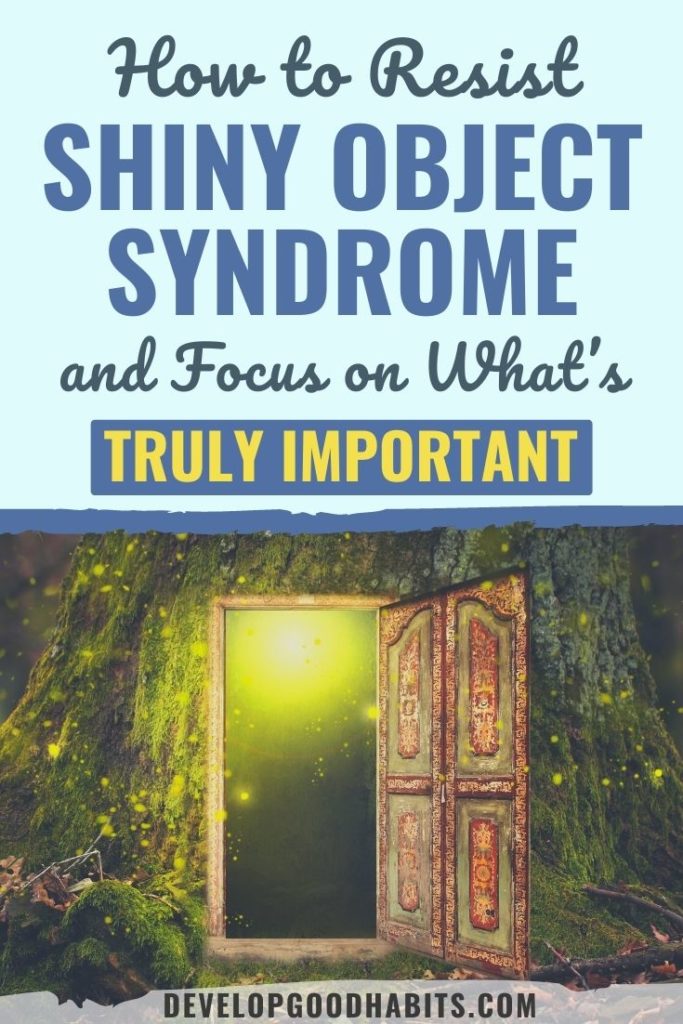There might be affiliate links on this page, which means we get a small commission of anything you buy. As an Amazon Associate we earn from qualifying purchases. Please do your own research before making any online purchase.
Are you an entrepreneur or a creative person?
If so, you probably have dozens of ideas that constantly run through your head.
You feel excitement over these possibilities (or shiny new things) because it is the opportunity to do something fun and different. And you feel like if you don’t take action on a new idea, you’ll experience the fear of missing out.
If this sounds like you, then you’re probably experiencing what’s commonly known as “shiny object syndrome.”
In this article, we’ll define shiny object syndrome, the negative effects it can have on your life, and six simple strategies you can use to avoid it.
What Is Shiny Object Syndrome?
In the business world, shiny object syndrome has been identified as the tendency of entrepreneurs to start projects based on ideas without properly assessing the long-term goals, feasibility, and sustainability of the projects, which leads them to not complete anything.
These business owners tend to take their companies in many different directions. This tendency has been likened to the way children chase after a shiny object. After reaching the shiny thing and seeing what it is, they quickly lose interest and go after something else that captures their attention.
What causes shiny object syndrome? When entrepreneurs and business owners lack the clarity, confidence, and capabilities needed to make real progress toward their long term goal. They have a long list of projects and a shorter list of projects that have been completed.
Frustration with goals, progress, and performance can also cause shiny object syndrome. You find yourself in a constant state of comparison while fearing missing out.
What Are the Negative Effects of Being Distracted By “Shiny Objects?”
Shiny object syndrome can negatively impact your personal success in several ways. First, it leads to an inability to complete projects. If you don't think through a project before implementing it, you will likely run into unforeseen obstacles that you may be unprepared to overcome. In this case, you may choose to abandon the project because it becomes more trouble than it is worth, losing countless hours of your time in the process.
4 Free SMART Goal Setting Worksheets and Templates
Another reason you may leave a project unfinished is that, halfway through working on it, you get a new brilliant idea that seems even better.
You may push your current project to the side to begin your new endeavor and then never return to your original task. Unfortunately, this means that you will never see the results that may have come from your first project.
Repeatedly running into dead ends on projects and never seeing them to fruition can lead to feelings of frustration about your unrealized potential. Frustration stems from a failure to achieve your most coveted goals because after starting with high hopes and aspirations, your dreams continue to be crushed.
When you have shiny object syndrome in business, you don't want to consider the obstacles that could get in the way of achieving your goals, so when you see something you want, you just go for it. However, when working with this kind of compulsion, the process is bound to be stop-and-go.
Shiny object syndrome can lead to wasting money. In fact, research has shown that entrepreneurs who jump too quickly into new ideas without thinking them through end up costing their companies thousands of dollars in resources, time, and productivity.
With continuously having unfinished projects that never end up making the company any money to pay back their costs, the company gains little or no return on investment. The company also suffers opportunity costs because these dead-end projects waste the employees' time when they could be working on more productive endeavors.
Further, as employees are constantly finding themselves faced with roadblocks, their work productivity becomes disrupted. All of that momentum that people have at the beginning of projects comes to a halt regularly, and employees are constantly running out of steam.
Productivity is already a leading problem in the business arena, as it remains the weakness at the core of the developed world, so adding in factors that contribute to this problem only makes it worse.
10 Habits to Help you Learn How to Improve Focus
Finally, if a job involves too much pressure without providing any productive results in return, it harms people's loyalty to a company. The truth is, most ideas that are born from shiny object syndrome aren’t worth the necessary follow-through.
Their end value isn’t evident, and when the tasks related to the idea are delegated to employees who aren't given any direction, it can lower morale because employees become frustrated by continuously changing plans.
People want to be fulfilled in their jobs and their lives, and if they are never able to finish what they start or see results from all of their hard work, they are likely to move on to somewhere that can provide them with that.

What Is the Opposite of Shiny Object Syndrome?
The key to overcoming shiny object syndrome is to be mindful of your true intentions. Because just like “shiny objects” can distract you from your purpose, a bad mindset keeps you wasting time, money, and energy after something has failed.
This is known as sunk cost fallacy.
This is the belief that the money, time, and effort we have already spent trying to make something succeed necessitates continuing even after good sense would show that success is highly unlikely.
[Find out more about sunk cost fallacy and what you can do about it.]
How to Resist Shiny Object Syndrome
Realizing that you are easily distracted by new ideas is the first step to helping you find ways to resist the pull of shiny objects. Here are some strategies for how to avoid shiny object syndrome.
1. Set long-term and short-term goals for you and your business
Goal setting is not simply a one-time thing that you do when coming up with a business plan. It is an ongoing process that constantly evolves as your business grows and the market changes. Even if your business is flourishing, having goals will help you maintain the momentum you need to stay on top and give you a safety net for inevitable downtimes.
It’s tough to commit to a project if your finish line is vague or indefinite. So before moving forward, make it extremely clear what your outcome will look like. Figure out exactly what you want, how you will get there, and your timeline.
Even small, short-term goals that you set amid a crisis could positively affect things when things improve. Instead of mindlessly jumping around from project to project, set goals to help yourself take a breath before changing direction. Short-term goals can help keep your team focused and working together cohesively.
Your short-term goals are often the stepping-stones to accomplishing your long-term goals. Set long-term goals for all of your projects, including how long you think the project will take to complete.
If you have your goals set in stone, whenever a shiny object idea comes to mind, you can analyze how the idea may fit in with your current objectives. This may be a quick way to rule out your new idea if you can see that it will not help you progress toward whatever you are working for.
Goal setting is an ongoing process that constantly evolves as your business grows and the market changes.
2. Commit to reaching your goals without getting sidetracked
To overcome shiny object syndrome, there needs to be some kind of accountability. Once your goals are set, don’t abandon your project until complete. This will help prevent you from wasting resources by walking away from a half-finished project before seeing any of its payback or results.
The only exceptions to this rule will be if you find that your project is beginning to cost you more money than you initially estimated or if the circumstances within your company or in the field have changed significantly enough to diminish the project's effectiveness completely.
You need to do a few things to make a true commitment to the project at hand. First, tell yourself that you won't let anything stand in your way. Get into the mindset that you will complete this project because it will positively impact you or your company in the end.
You will also need to focus on what's important (this is especially important if you feel like your schedule is constantly packed). You have to be ruthlessly selective about what you do and the tasks you pass on.
Finally, you will need to hold yourself accountable for the work you plan to do. Keep other people in your company updated, or use a weekly goals system to keep track of your critical tasks.
What Type of Goals Should You Set When You Have No Idea What You Want?
3. Sleep on an idea before acting on it
Before delegating work to your team on a new project that you are “sure” will be a game-changer, take some time to think about it. You simply can't act on every idea you have, so it is important to give yourself a buffer period to spare yourself from rushing into a hasty decision.
Psychologists have found that sleep improves people's ability to think of creative solutions to issues they are facing by helping the brain recognize unrelated ideas creating connections among one's current knowledge.
Psychologists have concluded that REM sleep is more effective than any other state of promoting creative thinking. This suggests that if you allow yourself time to sleep on an idea, you may wake up with a new perspective.
4. Do more research on the feasibility and sustainability of an idea before launching it
Do your research and think about whether your idea will best use your company’s resources. Any successful business venture must have a viable business concept and a realistic plan.
While you may be passionate about your business idea, you can't forget to consider the costs associated with the project, the time it will take to complete, and any regulation procedures and policies you must follow.
Adapting and incorporating new ideas into your business is one way to remove some of the inevitable uncertainties that every business faces, but if you don't do enough research and planning, your new ideas may not succeed.
If you conduct a feasibility study, you will be giving yourself a chance to get answers to important questions that will help you assess the project's potential and determine the likelihood that the project will succeed or fail.
5. Communicate with your team or people close to you regarding new ideas that you plan to try
This is especially helpful if you work with someone who is skillfully skeptical, can be direct, and is talented at pointing out the potential obstacles of a new idea. Ask your team to flesh out your new idea, ask you difficult questions, and find any possible weaknesses. Doing this will allow your team to help you realize if you need to pump the brakes.

Listen to their suggestions, perspectives, and/or concerns before you decide. If an idea survives through this stage, it may be worth pursuing. If you do follow through with your idea, your team will be happier that you talked to them first.
If you are used to thinking of a new idea and immediately acting on it exactly how you see fit, it may take some practice to start taking a step back to get other people's opinions. But this will always help you get a new perspective and refine your idea.
6. If you’re running a business, consider this question: What value will your new idea/project add to the customer experience?
The success of your business begins with your customers, so the first step is to put yourself in your customers’ shoes. Think about the added benefits that your customers will get from your new project.
Maybe your new idea will ultimately save your customers time, effort, or money somehow. Or perhaps it will increase their commitment to your company. Start with considering the value you are adding to your customers' experience to reinforce the “customer first” way of thinking.
It is important to recognize that doing things that please your customers is a waste of time if it doesn't add value. For example, if your company has a goal of responding to customers within 24 hours and you do everything you can to meet that goal, your customers may appreciate this. However, doing this doesn't necessarily add business value.
27 Best Books on Productivity and Time Management to Get Things Done!
While your company may be the first to respond, your customers may still have to wait to hear back from other companies for quotes before they start considering which company to work with. While responding to the customer quickly may have added a bit of possible value, the truth is that other larger factors impact the customer's satisfaction.
7. Try saying no more often
When you learn how to set boundaries when it comes to your time, you will find that you can stop chasing shiny objects. On the other hand, saying yes to every opportunity that pops up will cause you to continually chase shiny objects, lose focus, and put you in a constant state of feeling frustrated and overwhelmed.
Make sure you are clear on your goals and have a path to follow. Any new requests for your time and energy should align with your current goals.
8. Let go of the comparisons
As briefly mentioned above, comparison syndrome is one of the biggest causes of shiny object syndrome. Stop comparing your progress and success with others. If you aren't on the same level, this can cause you to feel as if you have failed.
You may then waste valuable time chasing down what made these other people successful (the proverbial bright shiny object), which takes you away from your own goals and path as you chase a new thing that just doesn't align with your business model.
Instead, stop comparing yourself to others, follow your clear goals, and be grateful for what you have and what you have already accomplished.
9. Go ahead and adopt a wait-and-see approach
If you aren't sure about new opportunities, it is okay to adopt a wait-and-see approach. To determine if something is a shiny object or a real advantage, take your time to research it and assess if it is something your business needs.
10. Learn how to differentiate between shiny objects and your real opportunities
You also need to learn how to distinguish between what an actual real opportunity is and what a new shiny object is. A new shiny object can appear exciting and interesting, but ultimately, it is a distraction and probably won't add any real value or worth to your life.
By the time you are done playing with your shiny new object, you will realize you didn't really need to waste your time on it, and there are several unfinished projects left in its wake.
Instead, watch for real opportunities that will impact what you are doing. Find what can improve workflow and help grow your business. Find tools that help you better engage with customers and ensure you deliver the best products and services possible as a business owner.
Summing It Up: Shiny Object Syndrome
In a nutshell, shiny object syndrome is the tendency of an individual to start projects based on ideas. The projects may or may not succeed, but they will likely be abandoned before completion because the person will start working on something else.
Loving innovation is actually a good thing. However, you should never lose sight of what’s important for your customers, your business, and you. If you find that you fall victim to shiny object syndrome, it's time to reframe your thinking and improve your business. Find ways to avoid shiny new things and stay focused on the bigger picture.
Finally, if you want to level up your productivity and time management skills, then watch this free video about the 9 productivity habits you can build at work.


